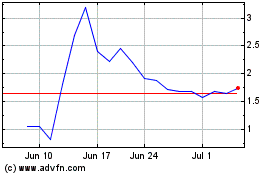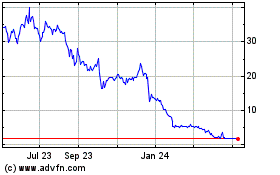Longeveron Inc. (NASDAQ: LGVN) ("Longeveron" or
"Company"), a clinical stage biotechnology company developing
cellular therapies for chronic aging-related and life-threatening
conditions, announced preliminary top line results from ongoing
biomarker analysis from the Company’s Phase 2b trial of Lomecel-B
investigational cell therapy in Aging Frailty subjects.
Biomarker analysis, which is considered exploratory in this
trial, revealed that administration of Lomecel-B was associated
with a statistically significant reduction in serum levels of
soluble TIE-2 (sTIE-2) in a dose-dependent fashion at Day 270
compared to placebo. The levels fell by -243.13 ± 1073.21 pg/mL for
the combined Lomecel-B arms (95% CI -519.69, -93.61; p=0.0051) at
270 days as compared to an increase of 356.03 ± 1018.95 pg/mL in
the placebo group (95% CI -4.06, 786.87; p=0.0524). The difference
between the placebo and high dose Lomecel-B (200 million cells) is
-936.85 pg/mL (95% CI -1640.27, -233.43; p=0.0095). It is known
that reductions in sTIE-2 correlate with anti-inflammatory and
pro-vascular effects [1, 2], while elevated levels of sTIE2 have
been observed in patients with peripheral arterial disease (PAD)
[3].
TIE-2 is a cell surface receptor tyrosine kinase that can
activate biochemical pathways to promote vascular (blood vessel)
health [1, 2, 4]. This receptor is present on cells that line blood
vessels, and protects against vascular leakage and inflammation [5,
6]. However, TIE-2 can be cleaved from the cell surface, which
increases the levels of sTIE-2 in the blood stream [7]. As such,
increased levels of sTIE-2 in the blood stream may be indicative of
poor vascular health [3] and endothelial dysfunction [8, 9]. Since
poor vascular health and endothelial dysfunction are associated
with the onset and development of frailty in older adults [10, 11],
the finding that Lomecel-B can reduce sTIE-2 suggests that
improving vascular and endothelial function may be a potential
mechanism of action of this product. This is the first time that a
cell therapy has been associated with a reduction in sTIE-2 in the
blood stream.
The Company plans to further explore the Tie-2 changes in
additional subject populations with Aging Frailty.
Virtual PresentationJorge Ruiz, M.D., Associate
Director for Clinical Affairs at the Geriatric Research, Education
and Clinical Center (GRECC), Miami Veterans Affairs Healthcare
System, and lead investigator in the trial, will present the
results from the trial titled: A Phase 2b, Randomized, Blinded and
Placebo-Controlled Trial to Evaluate the Safety and Efficacy
of Lomecel-B Infusion in Patients With Aging Frailty (the
“Phase 2b trial”) at the 2021 11th Annual International Conference
for Frailty & Sarcopenia (ICFSR).
Today’s slide deck will be available on the Company’s “Events
& Presentations” page and the webcast of the presentation will
be made available on the Company’s website after the
conference.
About the Phase 2b Trial
The Phase 2b trial, which was partially funded
by a Small Business Innovation Research (SBIR) grant from the
National Institute on Aging (NIA), evaluated the safety and
efficacy of a single peripheral intravenous infusion of four
different doses of Lomecel-B cell therapy (25 million (n=37), 50
million (n=31), 100 million (n=34) and 200 million (n=16) cells.
The primary objective of the study was to assess the effect of
Lomecel-B treatment on exercise tolerance and endurance via the
six-minute walk test (6MWT).
- Results showed that frail subjects (average age of 75.2 years)
with impaired mobility could walk nearly 50 meters further 180 days
after a single infusion of Lomecel-B (200 million Lomecel-B group;
p=0.0065). This increase persisted through 270 days (200 million
Lomecel-B group change from baseline 47.9 meters; p=0.0115, and
p=0.0077 compared to placebo). By comparison, the placebo-treated
subjects change from baseline at 180 days and 270 days was 8.0
meters (p=0.5371) and -15.5 meters (p=0.2728), respectively.
Additionally, results showed a clear, statistically significant
dose-response curve at day 180 using the 6MWT endpoint.
References1. Ghosh, C.C., et al., Gene
control of tyrosine kinase TIE2 and vascular manifestations of
infections. Proc Natl Acad Sci U S A, 2016.
113(9): p. 2472-7.2. Han, S., et al.,
Amelioration of sepsis by TIE2 activation-induced vascular
protection. Sci Transl Med, 2016. 8(335): p.
335ra55.3. Findley, C.M., et al., Plasma levels of soluble Tie2 and
vascular endothelial growth factor distinguish critical limb
ischemia from intermittent claudication in patients with peripheral
arterial disease. J Am Coll Cardiol, 2008. 52(5):
p. 387-93.4. Maisonpierre, P.C., et al., Angiopoietin-2, a
natural antagonist for Tie2 that disrupts in vivo angiogenesis.
Science, 1997. 277(5322): p.
55-60.5. Augustin, H.G., et al., Control of vascular
morphogenesis and homeostasis through the angiopoietin-Tie system.
Nat Rev Mol Cell Biol, 2009. 10(3): p.
165-77.6. Kelly-Goss, M.R., et al., Dynamic,
heterogeneous endothelial Tie2 expression and capillary blood flow
during microvascular remodeling. Sci Rep, 2017.
7(1): p. 9049.7. Reusch, P., et al.,
Identification of a soluble form of the angiopoietin receptor TIE-2
released from endothelial cells and present in human blood.
Angiogenesis, 2001. 4(2): p.
123-31.8. Idowu, T.O., et al., Identification of
specific Tie2 cleavage sites and therapeutic modulation in
experimental sepsis. Elife, 2020.
9.9. Thamm, K., et al., Molecular
Regulation of Acute Tie2 Suppression in Sepsis. Crit Care Med,
2018. 46(9): p. e928-e936.10. Alonso-Bouzon, C.,
et al., Association between endothelial dysfunction and frailty:
the Toledo Study for Healthy Aging. Age (Dordr), 2014.
36(1): p. 495-505.11. Amarasekera, A.T., et al.,
Does vascular endothelial dysfunction play a role in physical
frailty and sarcopenia? A systematic review. Age Ageing, 2021.
50(3): p. 725-732.
About Lomecel-B
Lomecel-B is a proprietary allogeneic product
comprised of medicinal signaling cells (MSCs) from the bone marrow
of adult donors and culture-expanded in Longeveron’s current good
manufacturing practice (cGMP) cell processing facility.
About Longeveron Inc.
Longeveron is a clinical stage biotechnology
company developing cellular therapies for specific aging-related
and life-threatening conditions. The Company’s lead investigational
product is the LOMECEL-B™ cell-based therapy product (“Lomecel-B”),
which is derived from culture-expanded medicinal signaling cells
(MSCs) that are sourced from bone marrow of young, healthy adult
donors. Longeveron believes that by using the same cells that
promote tissue repair, organ maintenance, and immune system
function, it can develop safe and effective therapies for some of
the most difficult disorders associated with the aging process and
other medical disorders. Longeveron is currently sponsoring Phase 1
and 2 clinical trials in the following indications: Aging Frailty,
Alzheimer’s disease, the Metabolic Syndrome, Acute Respiratory
Distress Syndrome (ARDS), and hypoplastic left heart syndrome
(HLHS). The Company’s mission is to advance Lomecel-B and other
cell-based product candidates into pivotal Phase 3 trials, with the
goal of achieving regulatory approvals, subsequent
commercialization, and broad use by the healthcare community.
Additional information about the Company is available at
https://www.longeveron.com/.
Forward-Looking and Other Statements
Certain statements in this press release that
are not historical facts are forward-looking statements that
reflect management's current expectations, assumptions, and
estimates of future performance and economic conditions, and
involve risks and uncertainties that could cause actual results to
differ materially from those anticipated by the statements made
herein. Forward-looking statements are generally identifiable by
the use of forward-looking terminology such as "believe,"
"expects," "may," "looks to," "will," "should," "plan," "intend,"
"on condition," "target," "see," "potential," "estimates,"
"preliminary," or "anticipates" or the negative thereof or
comparable terminology, or by discussion of strategy or goals or
other future events, circumstances, or effects. Moreover,
forward-looking statements in this release include, but are not
limited to, statements about the ability of our clinical trials to
demonstrate safety and efficacy of our product candidates, and
other positive results; the timing and focus of our ongoing and
future preclinical studies and clinical trials; the size of the
market opportunity for our product candidates, the beneficial
characteristics, safety, efficacy and therapeutic effects of our
product candidates; our ability to obtain and maintain regulatory
approval of our product candidates, our plans and ability to obtain
or protect intellectual property rights, including extensions of
existing patent terms where available and our ability to avoid
infringing the intellectual property rights of others. Further
information relating to factors that may impact the Company's
results and forward-looking statements are disclosed in the
Company's filings with the SEC. The forward-looking statements
contained in this press release are made as of the date of this
press release, and the Company disclaims any intention or
obligation, other than imposed by law, to update or revise any
forward-looking statements, whether as a result of new information,
future events, or otherwise.
Investor Contact:Brendan PayneStern Investor
Relations212-698-8695brendan.payne@sternir.com
Longeveron (NASDAQ:LGVN)
Historical Stock Chart
From Mar 2024 to Apr 2024

Longeveron (NASDAQ:LGVN)
Historical Stock Chart
From Apr 2023 to Apr 2024
